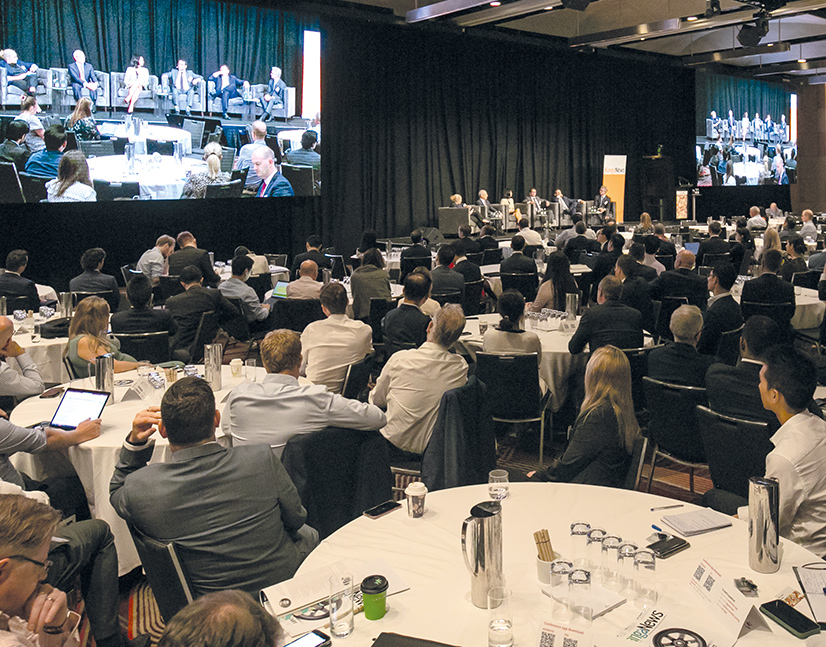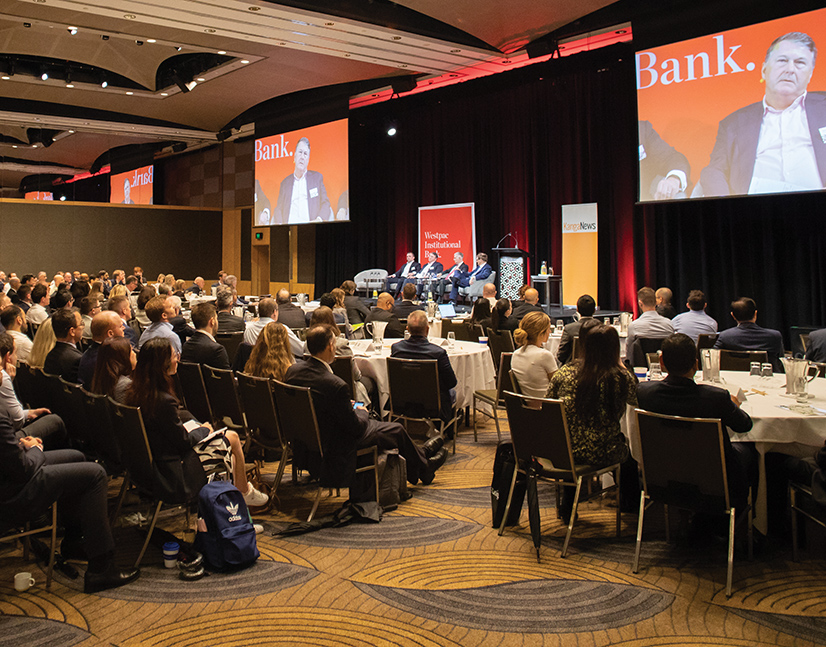
Conservative credit settings counter inflation risks
On 1 November, Fitch Ratings hosted its inaugural Women in Credit event in Sydney to align with its core values of embracing diversity, equity and inclusion. More than 20 female institutional investors attended the event, hearing and commenting on Fitch analysts’ views on the geopolitical, business and finance landscape, and trends and challenges for the buy side to watch.
Helen Craig Head of Operations KANGANEWS
The conversation with the analysts took in a wide range of topics, including how corporates are managing the economic cycle and the rising interest rate environment with an eye to funding challenges, overlaid with the growing challenge of energy transition. The group also discussed performance trends within Australian structured finance and shared views on the much-scrutinised office REIT sector.

On 1 November, the day of the lunch, CoreLogic published its latest home value index data. This showed a 0.9 per cent rise in the month of October on the back of a 0.7 per cent rise the previous month. This is despite a backdrop of rising interest rates in Australia – with the 4.1 per cent cash rate at the time of the event increased by a further 25 basis points a week later.
Natasha Vojvodic, senior director, structured finance at Fitch in Sydney, said residential mortgage-backed securities (RMBS) performance remains “surprisingly” robust across prime and nonconforming collateral. The rising rate environment has driven prime and nonconforming borrower arrears to around 1 per cent and 3 per cent respectively, but this is no more than a return to close to historical norms from all-time low arrears in 2022.
“Unemployment is key, and low unemployment is why Fitch has not been expecting a material increase in defaults – although we were expecting the rate to be marginally higher than what we have seen so far,” Vojvodic commented. “When we last experienced consecutive interest rate rises, in the wake of the global financial crisis, arrears increased. But unemployment wasn’t as low then as it is now.”
DE&I inside and out
Diversity, equity and inclusion (DE&I) are core values at Fitch Ratings. In line with its DE&I approach, Fitch hosted its first-ever all-female Australian credit roundtable for its analysts and investor clients.
Fitch believes diverse teams achieve better results by leveraging a broad set of ideas and perspectives. Its goal for the 1 November event was therefore to provide a sector update for Australian credit by giving the rating agency’s latest views in an interactive and engaging discussion, while at the same time providing an opportunity to promote gender diversity via networking and conversation.
Vicky Melbourne, managing director, corporate finance at Fitch, noted the pleasing level of engagement from women in the institutional funds management sector. Although she acknowledged that Fitch still has progress to make when it comes to gender diversity in senior analytical positions in some divisions, she said the rating agency has a diverse pool of female analysts across corporate and structured finance – the two main areas of coverage represented at the discussion.
Jane Beresford, director, investor development at Fitch in Sydney, told attendees she has also observed pleasing advancements in gender diversity during the last two decades she has spent working in the financial markets industry.
In her welcoming comments, Beresford referenced the World Economic Forum’s global gender gap report conclusion that female talent in finance is still one of the most untapped business resources globally. In this light, Beresford identified key initiatives in Fitch’s corporate social responsibility strategy including the integration of DE&I within its principles across all aspects of its business.
“We are trying to transform the way we attract, hire and engage with the market and to develop unrepresented talent at all levels,” Beresford told the group. “It is not just about long-term targets but gradually increasing the proportion of women across credit markets at senior executive levels. This, and developing an inclusive culture in which we can all work and thrive, is the genesis for developing today’s women’s credit forum.”
With this as the context, Beresford told attendees at the forum: “The question we are asked is ‘why?’. The simple answer, and our ultimate goal, is so we can all have a positive culture in which we can work and thrive, and so this talent can become available to the market.”
Lenders have been proactive in preparing for higher delinquencies, including by taking a forward-looking view on household stress and bolstering their servicing teams as a result, added Savithri Tharmarajah, associate director, structured finance at Fitch in Sydney. “Large savings buffers accumulated by borrowers through the pandemic era have been supportive in the last couple of months and will continue to be helpful in the short term, as the impacts of interest rate rises continue to come through.”
Yet despite savings buffers and low unemployment, Kelly Amato, senior director, corporate finance at Fitch in Sydney, said Australian households are putting on the brakes in discretionary spending. She explained: “Savings buffers were supportive of retail for some time, owing to pent-up demand in the wake of COVID-19. However, the impact is now reducing. At one end of the spectrum, consumers are moving away from big-ticket purchases, while at the other end when they are buying necessities like groceries, they are moving toward cheaper, home-brand goods.”
While Australian households have started to feel the pinch, immigration has helped make the retail sector resilient. Even so, Fitch’s analysts expect tougher times to come. “Looking forward, we expect the environment to start to bite – particularly among lower socioeconomic groups – with rising inflation and energy prices. Further reserve bank actions could add to these pressures on Australian households,” Amato said. “This is not only by way of the mortgage channel but also rent increases. It will be interesting to see how households respond and from where else they start to cut discretionary spending.”
Vojvodic said Fitch has not witnessed a significant deterioration of asset performance in the areas where it believes early warning signs are most likely to appear: a cross-section of nonprime collateral including RMBS, auto loans and credit card receivables.
She revealed: “If payment rates for credit cards start to fall, this obviously means credit card holders are not paying their monthly bills in full. We aren’t observing any deterioration here or in any other traditional warning sectors at the moment, but we are keeping a close eye as this is where we would expect deterioration to come through.”


Vojvodic said Australian RMBS collateral continues to perform well relative to global equivalents, which she suggested is even more noteworthy considering Australia is predominantly a variable-rate market and thus more vulnerable to higher interest rates. Performance in the residential market is also underpinned by housing undersupply – in contrast to countries like Ireland, which experienced pressures on collateral due to a housing overbuild.
“It is 30 years since Australia has been in recession, and one would assume it has to happen at some point,” Vojvodic told attendees at the Fitch event. “But local underwriting has been consistently strong, even through the financial crisis, driven by robust mortgage insurance and standardisation of underwriting practices. More nonprime collateral has been written in the last few years, in concert with the growing nonbank market – but even here, relative to its peer countries, Australian underwriting remains strong.”
REITs FEEL THE HEAT
In another property sector, the pandemic impact on REITs has been notable, with falling valuation a consistent theme of the most recent corporate reporting season, especially in the office sector. It normally takes a couple of reporting periods for this data to wash through, Amato said – and she therefore predicts further deterioration.
Fitch has focused on determining the potential impacts of the expected downturn on the credit profiles of REITs to get a handle on whether it is likely to evolve into forced selling and thus a more structural concern.
“We have carried out sensitivity analysis on leverage levels,” Amato revealed. “Coming into this period, REITs had very low leverage levels to the extent that reaching the upper boundary of their target gearing range would have required significant valuation decline. Then to breach their covenant levels still requires around another 20 per cent jump in leverage on top of that.”
Amato drew comparisons with the retail sector half a decade ago, where high-end shopping malls fared better than their lower-quality peers. “Even though there is starting to be a bifurcation in assets, the new hybrid working model suggests demand for office space should remain even if it falls at the margin. Capex spend is also a key factor we are monitoring: some of the larger REITs are already delaying projects or securing more capital partnerships before final approvals for projects they are proceeding with, to lower their own risks and exposure.”


Forced sales are where most of the concerns lie as these crystalise the risk from lower valuations, Amato explained. But the major REITs have already started to shift their book valuations down and have strong balance sheets to absorb valuation declines without being forced sellers. Further, these REITs’ portfolios typically focus on higher quality office assets, rather than lower-tier office buildings – which are under the most pressure from companies requiring less office space because of the hybrid office and home working model.
The sector has certainly been in the headlines. In October 2023, Australian Retirement Trust divested a New York office tower bought by QSuper in 2017, cutting its losses after a collapse in occupancy. Although the causes appear to have been idiosyncratic in this case, falling valuations have caused other investment firms to make similar decisions to withdraw from office-related investments in 2023.
Helen Mason, Sydney-based fund manager and senior credit analyst at Schroder Investment Management, suggested that the potential for this to flow through to Australia’s listed REIT space is a cause for concern. She explained: “Private credit has grown dramatically over the past 10 years and, with the global reach for yield, superannuation funds have taken property assets onto the balance sheet at, arguably, inflated prices. We now have an example of a super fund ‘handing the keys back’, though in fairness this is probably very unlikely to happen in Australia.”
Mason continued: “It has helped Australian office valuations that there is currently very little transactional evidence for high-quality buildings, as well as the fact that only a small proportion of properties are annually externally valued. In my opinion, this has provided support to the sector. But if we end up in an environment where interest rates are higher for longer, it will be harder for valuations to hold up.”
Amato said outright demand is roubust so far, but this is not the only factor at play. She commented: “Occupancy rates for major Australian REITs remain very high and they have been able to let space relatively easily. However, we have seen incentives increase and achievable rental outcomes tell us that the office portfolio will not yield as highly going forward.”
With current challenges for office REITs, investors are watching the timing of new supply coming into the sector. Carola Wiksten, associate portfolio manager at Aware Super, noted: “Uncertain demand for office space combined with construction cost inflation may have an impact on the supply of new buildings. If demand improves over the coming years, this could be a positive for better quality office buildings in future.”
Fitch monitors the expected new supply pipeline as part of its research, including the net take up of office space. Amato told event attendees that net new supply and the pipeline of offices expected to complete over the next year is likely keeping lease incentives higher and net rents softer, especially in the Melbourne market.


However, new supply should start to decline thereafter. “At this point, we expect to see less competition for tenants, which will help the market find a new equilibrium,” Amato told attendees at the Fitch event. For now, for investors it is a case of monitoring REITs’ adjustment to the environment and using a disciplined credit process.
A niche area of the real estate sector that investors are also watching is data centres. Lucie Bielczykova, portfolio manager at Revolution Asset Management in Sydney, commented: “An AI search uses at least four times the amount of processing power of a standard Google search so there is clearly growth in the amount of data and processing required. On the other hand, there is always excess capacity in the data centre market.”
It is also an area that Fitch is keeping a close eye on. Amato said companies will vie to become market leaders as demand for AI continues to grow and bespoke facilities and requirements for running power gradually develop. “This means the structural fundamentals will come through. But, for now, the major Australian REITs don’t have this exposure.”
FINANCIAL RESILIENCE
A supportive balance sheet to be able to manage through periods of uncertainty provides considerable comfort. Vicky Melbourne, managing director, corporate finance at Fitch in Sydney, argued that Australian corporate treasuries learned some hard lessons during the financial crisis.
“Pre-crisis, they believed they did not need to pay to shore up their balance sheets simply in case they needed a buffer,” she said. “Post-crisis, they have substantially reshaped their balance sheets and significantly lowered their debt, and they have worked hard to deepen their relationships with lenders. Having untapped liquidity on the balance sheet has very much put Australian corporates in a strong position to weather the current downturn.”
Bielczykova agreed, noting similar observations from Revolution’s portfolios. “Australian corporates are very conservatively levered. Our view is corporates more generally entered this period with conservative balance sheets, providing buffers in leverage and leaving them with plenty of headroom in their covenants.”
The risk in the current environment is that an organisation could fall foul of multiple concurrent negative impacts that are sufficient to erode even these sturdier financial defences. But Amato added: “Australian corporates have typically put themselves in good positions, giving them tools to reduce pressure as the downturn comes. For instance, with rising interest rates we know funding costs will increase. However, companies can absorb these within their current rating levels because of their low leverage.”


TRANSITION INVESTMENT
The discussion also covered ground on the energy transition and the move to renewable energy. Fitch’s analysts have been paying particular attention to credits associated with transition, with a view to predicting which are best placed to manoeuvre the change.
At the top of the well-positioned list is Origin Energy. With its comparatively shorter-term supply contracts, it is able to move in and out of supply sources with less revenue volatility, analysts said. The demand for renewables projects coupled with a slow approvals process is driving a bottleneck in approvals and therefore those energy companies that are ahead of the game are more likely to emerge as the clear winners. Origin is a good example, Amato added, because it already has most of its renewable energy projects at the final investment decision stage.
“Plus, even amid government support for the transition to renewables, where legacy coal-fired plants need to remain open to make sure we have adequate base supply, one would think an agreed extension to mandated coal plant closure timelines would come with some level of government support. In other words, social obligation comes into play and support from the government could help energy generators avoid any losses as we navigate this transition,” Amato said.
Energy transition is also a focus for the structured finance market, Vojvodic suggested, given the impact of climate policy on asset valuations. “We can look at houses from the perspective of energy savings and installation,” she explained. “Where we have data, we can apply a haircut to the property price. However, in Australia, we just don’t have the data.”
Other jurisdictions have the benefit of better developed policy, Vojvodic continued. “A property valuation will be based on its current energy efficiency, which can also be upgraded or downgraded. It is an important data point to have, given assumptions that RMBS may not be called.”
The rubber is also meeting the road on energy transition for vehicles. Vojvodic said that while Fitch is not seeing a lot of electric vehicles (EVs) in the securitisation portfolios it rates, some 100 per cent EV asset-backed securities transactions have been executed around the world. “Recovery rates for EVs are lower given the pace at which the technology moves,” Vojvodic said.

nonbank Yearbook 2023
KangaNews's eighth annual guide to the business and funding trends in Australia's nonbank financial-institution sector.













